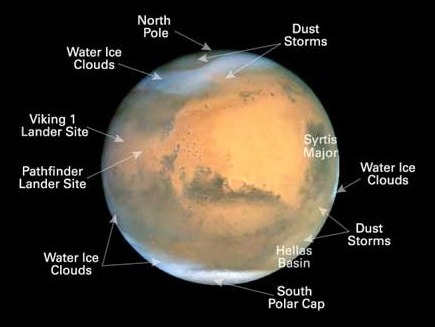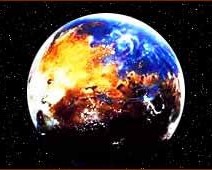 |
| What We Know About the Red Planet | ||||
| History | Water | Ice | Air | Canals |
| Seasons | Mountains | Rocks | SandDunes | Rift Valley |
| Moons | Dust Storms | Stats | Closest | Kid Pix |
| Lunar | Movies | Life Search | Wanted | Exploring Mars |
Mars relatively nearby in 2003:
Red Planet Closest to Earth in 59,619 Years
On August 27, 2003, at 9:51 a.m. Universal Time (5:51 a.m. EDT), the fourth planet from the Sun was closer to the third planet from the Sun than it had been in 59,619 years.
NASA graphic identifies Mars surface features
As the two major Solar System bodies orbited our star on that date, Mars was a mere 34.65 million miles from Earth. To be exact, the distance was:Earth is the third planet from the Sun and Mars is the fourth planet.
- 34,646,418 miles
- 55,758,006 kilometers
In opposition. The planetary situation on Aug. 27 was a perihelic opposition. That is, an opposition that occurs at perihelion, which is the point where Mars is closest to the Sun.
Mars perihelic opposition finds the Sun, Earth and Mars forming a straight line, bringing Mars and Earth relatively close together. Mars' perihelic oppositions occur only every 15 to 17 years.
Distances change. The elliptical orbits of the planets around the Sun bring them closer together during some oppositions than during other oppositions.
For instance, the ordinary opposition back in 1995 saw Mars come within 62.8 million miles of Earth. That was almost twice as far away as it was during the 2003 opposition.
Recent perihelic oppositions brought Mars about 35-36 million miles from Earth in 1956, 1971 and 1988. That compares with 34.65 million miles in 2003.
After passing the closest point on August 27, 2003, the planets began to pull away again.
When again? The next ordinary opposition of Mars will be in November 2005, when the planet will be some 43 million miles from Earth.
Although Earth and Mars come close to each other every 26 months, they rarely have been as close as they were in 2003.
Not all astronomers agree on how long it's been since such a close call last happened. All figure that it's been at least 5,000 years. Many astronomical calculators say it's been 59,619 years.
That means the last previous Earth inhabitants this close to Mars probably were the Neanderthals.
At any rate, modern astronomers say Mars will not make a closer visit to Earth until August 28, 2287, when the Red Planet will be 34,603,170 miles (55,688,405 kilometers) from Earth.
Similar close visits. Mars came almost as close to Earth back in 1924 when it was a mere 11,764 miles farther from Earth than in 2003.
In the future, 79 years from 2003, Mars will again make another very close approach to Earth on August 30, 2082. On that occasion, it will be just 78,487 miles farther from Earth than during the 2003 visit.
Mars oppositions replicate themselves on a 79-year cycle.
Astronomers loved 2003. Astronomers on Earth, both professional and amateur, benefitted from their spectacular close-up look at Mars, which made it appear bigger and brighter in their telescopes than ever before during human history.
The remarkable view revealed the Red Planet's whirling dust clouds and shiny south polar cap.
Mars is in the constellation Aquarius in our southeast sky.
When Mars is close to the Sun, the planet heats up and dust storms rise up. The southern polar ice cap shrinks during the Martian summer.
Acutally, Earth-bound astronomers were able to capture their best views just before August 27 as the dust storm season kicking up on the Red Planet began to obstruct details.
Learn more: Human Exploration of Mars:
There have been three stages of exploration so farFlybys:
Probes fly by Mars taking pictures Orbiters:
Spacecraft fly into orbit above MarsLanders and Rovers:
- Orbiters
- Mariner 8-9
- Viking 1-2
- Mars Observer
- Mars Climate Orbiter
- Mars Global Surveyor
- Mars Global Surveyor home
- 2001 Mars Odyssey
- 2001 Mars Odyssey home
- Mars Express
- Mars Express home
- Mars Reconnaissance Orbiter 2005
- Mars Reconnaissance Orbiter home
Landers and rovers drop to the surfaceSand dunes: Dust Storms: Air: Carbon Dioxide: Outflow Channels: Valley Networks: Rift Valley: Ice: Ice caps: Frost: Water: Artesian Water: Mars Weather: Mars Photo Galleries: Planet features: Canals: Rocks: Mountains: Dating and aging: Seasons:

